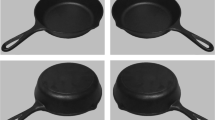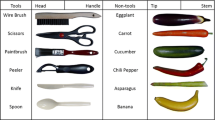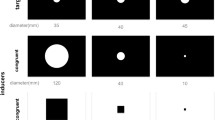Abstract
The affordance effect has been widely investigated employing various behavioral and brain-imaging techniques. Attempts to interpret the nature of the affordance effect led to two major views. Some researchers compare this kind of compatibility effect to the Simon effect, claiming abstract spatial association between the handle orientation of visually presented stimuli and the nearest response hand. Other authors advocate pure motor activation, during processing of visually presented tools without the involvement of spatial information. However, brain-imaging studies seem to agree that no action can be computed in the absence of spatial information. Taking the latter view into account, a divided visual field experiment was conducted, with the aim of crossing spatial and affordance correspondence effects. Overall, the results supported the view that motor and spatial information go hand in hand. Moreover, the data were in agreement with neuroimaging studies that show tool and affordance processing lateralization in the left hemisphere. The results are discussed in terms of neurophysiological data and brain mechanisms of perception and action.



Similar content being viewed by others
Explore related subjects
Discover the latest articles, news and stories from top researchers in related subjects.References
Buccino G, Sato M, Cattaneo L, Rodà F, Riggio L (2009) Broken affordances, broken objects: a TMS study. Neuropsychologia 47(14):3074–3078
Chao LL, Martin A (2000) Representation of manipulable man-made objects in the dorsal stream. Neuroimage 12:478–484
Cho D, Proctor RW (2010) The object-based Simon effect: grasping affordance or relative location of the graspable part? J Exp Psychol Hum Percept Perform 36(4):853–861
Creem-Regehr SH, Lee JN (2005) Neural representations of graspable objects: are tools special? Cogn Brain Res 22:457–469
Grafton ST, Fadiga L, Arbib MA, Rizzolatti G (1997) Premotor cortex activation during observation and naming of familiar tools. NeuroImage 6:231–236
Iani C, Baroni G, Pellicano A, Nicoletti R (2011) On the relationship between affordance and Simon effects: are the effects really independent? Eur J Cogn Psychol 23(1):121–131
Jeannerod M, Jacob P (2005) Visual cognition: a new look at the two-visual systems model. Neuropsychologia 43:301–312
Kosslyn SM (2010) Where is the “spatial” hemisphere? In: Reuter-Lorenz PA, Baynes K, Mangun GR, Phelps EA (eds) The cognitive neuroscience of mind: a tribute to Michael S. Gazzaniga. MIT Press, Cambridge, pp 39–58
Phillips JC, Ward R (2002) S–R correspondence effects of irrelevant visual affordance: time course and specificity of response activation. Visual Cogn 9:540–558
Proverbio AM, Adorni R, D’Aniello GE (2011) 250 ms to code for action affordance during observation of manipulable objects. Neuropsychologia 49:2711–2717
Rizzolatti G, Riggio L, Sheliga BM (1994) Space and selective attention. In: Umiltà C, Moskovitch M (eds) Attention and performance XV: Conscious and unconscious information processing. MIT Press, Cambridge, pp 231–265
Schneider W, Eschman A, Zuccolotto A (2002) E-Prime user’s guide. Psychology Software Tools Inc, Pittsburgh
Symes E, Ellis R, Tucker M (2005) Dissociating object-based and space-based affordances. Vis Cogn 12:1337–1361
Tucker M, Ellis R (1998) On the relations between seen objects and components of potential actions. J Exp Psychol Hum Percept Perform 24:830–846
Acknowledgments
We thank the anonymous reviewers for their useful comments and suggestions.
Conflict of interest
This supplement was not sponsored by outside commercial interests. It was funded entirely by ECONA, Via dei Marsi, 78, 00185 Roma, Italy.
Author information
Authors and Affiliations
Corresponding author
Rights and permissions
About this article
Cite this article
Vergilova, Y., Janyan, A. Combining motor and spatial affordance effects with the divided visual field paradigm. Cogn Process 13 (Suppl 1), 355–358 (2012). https://doi.org/10.1007/s10339-012-0464-x
Published:
Issue Date:
DOI: https://doi.org/10.1007/s10339-012-0464-x




